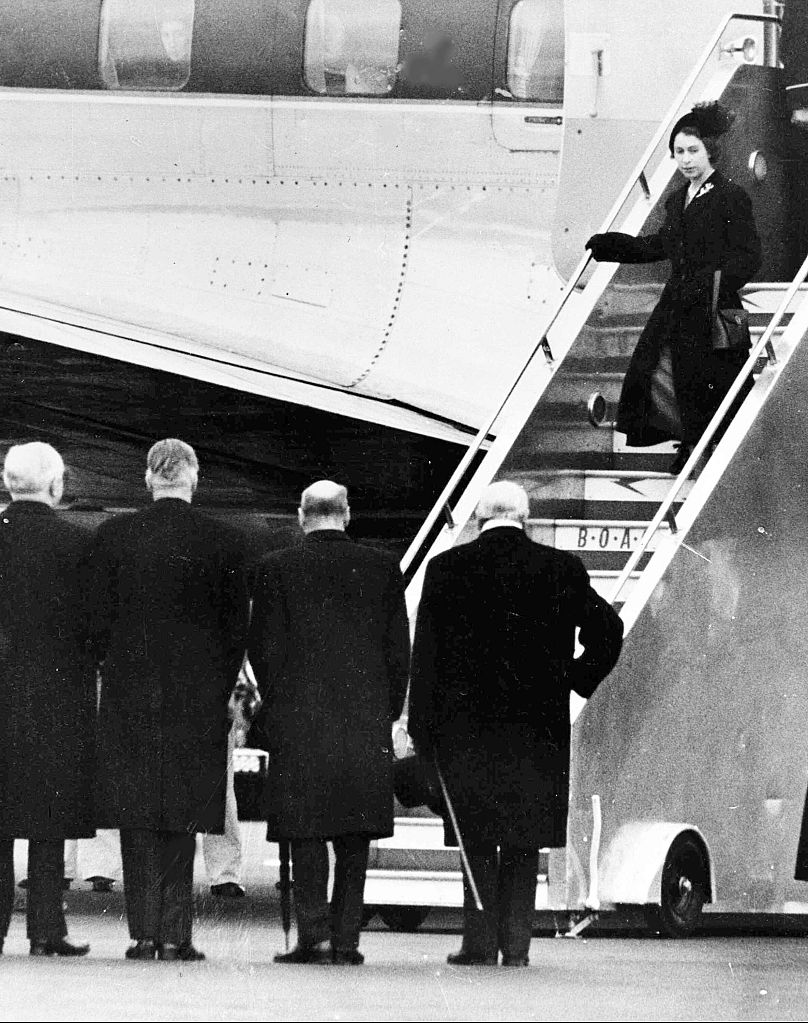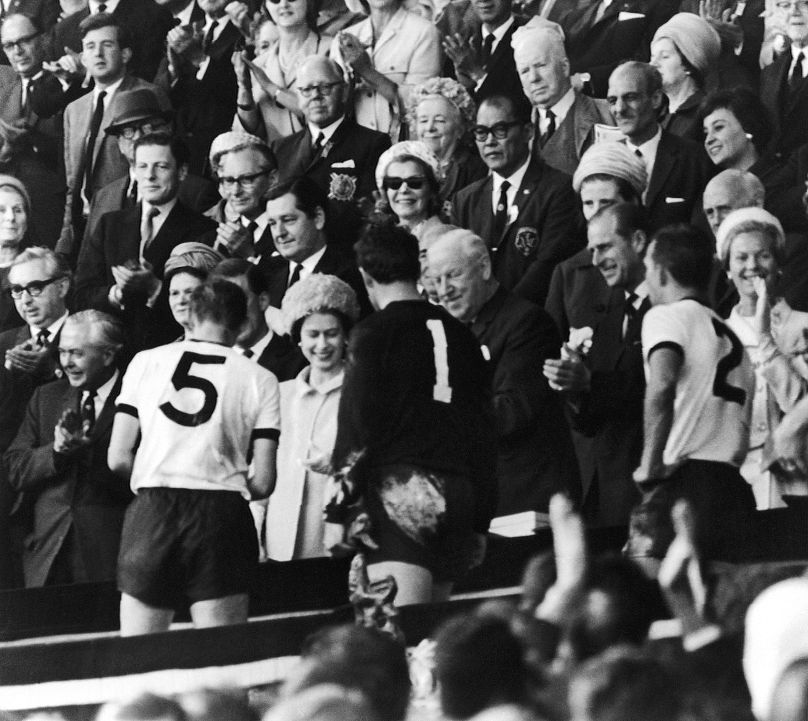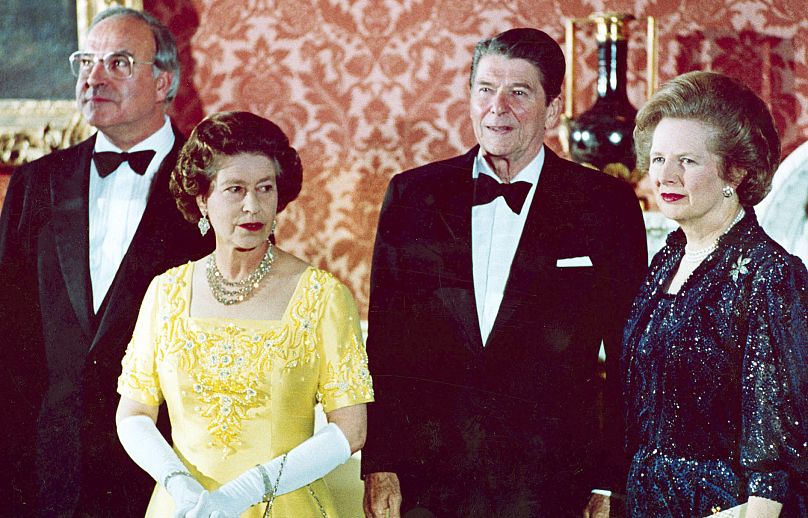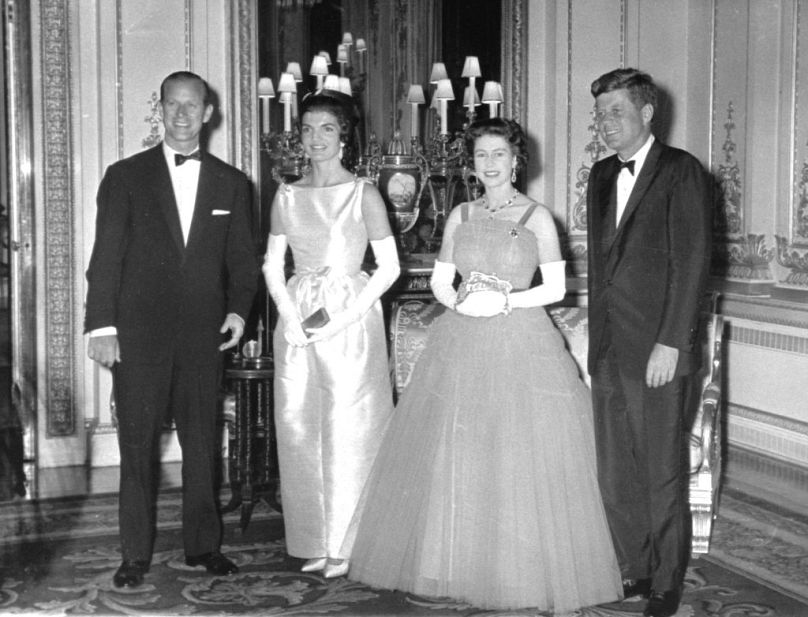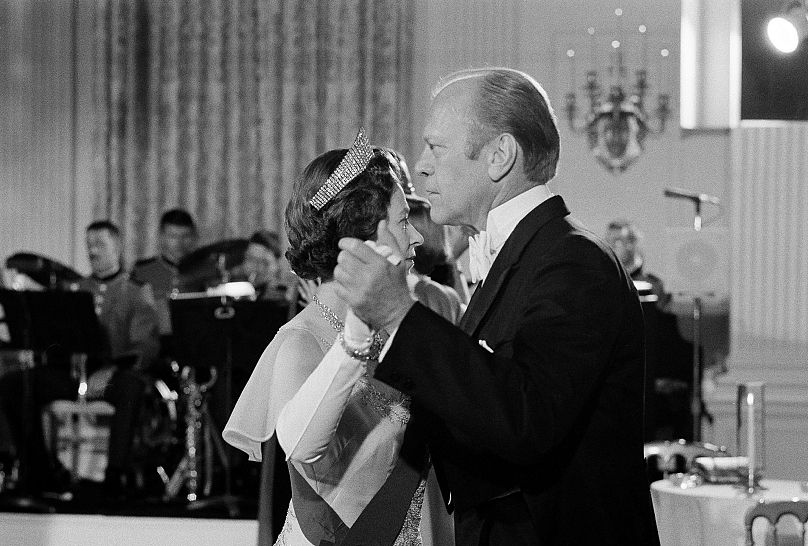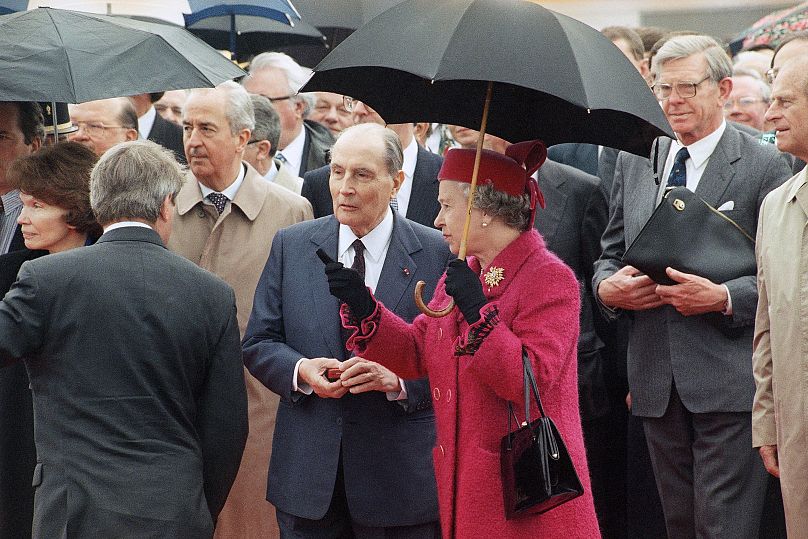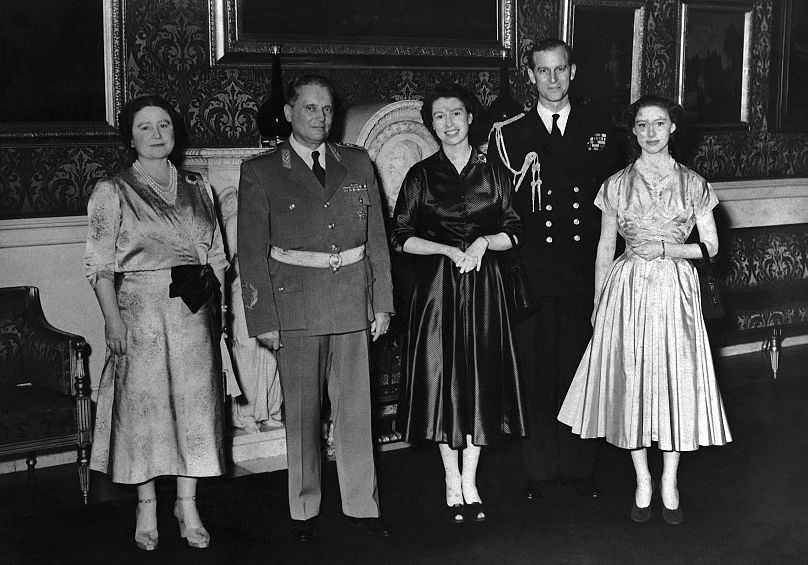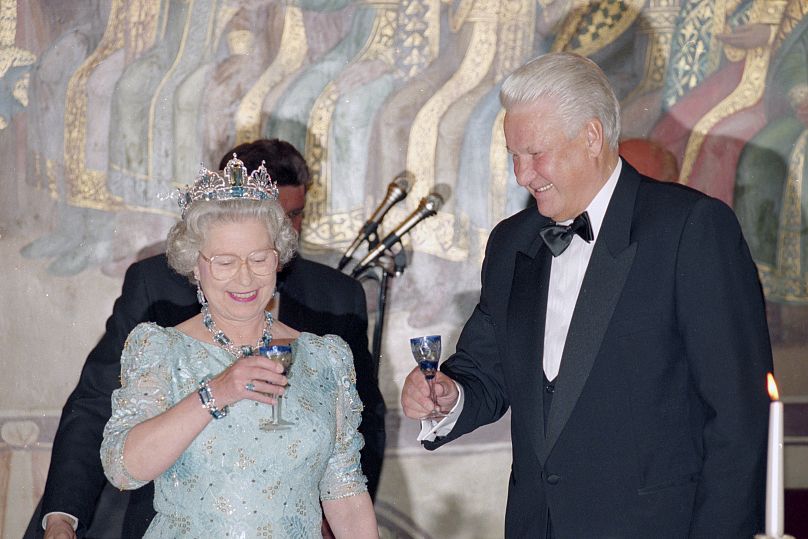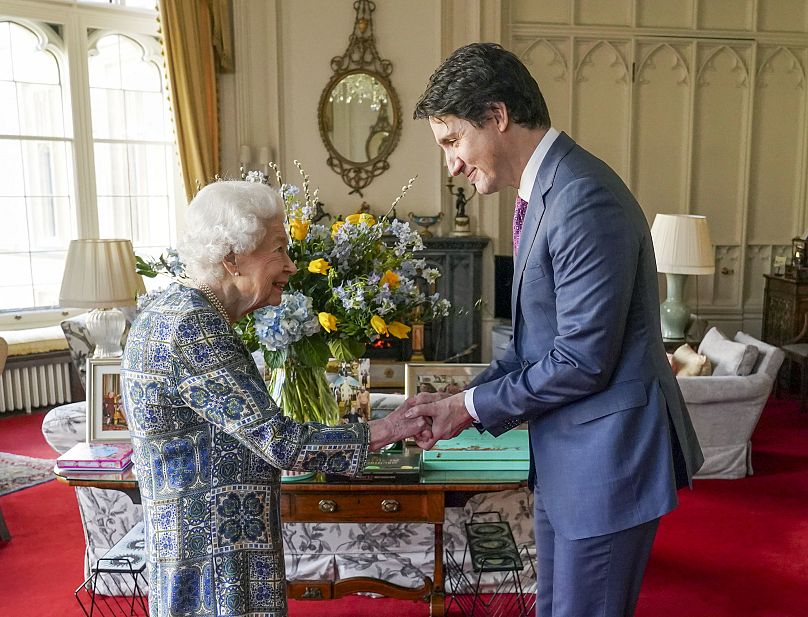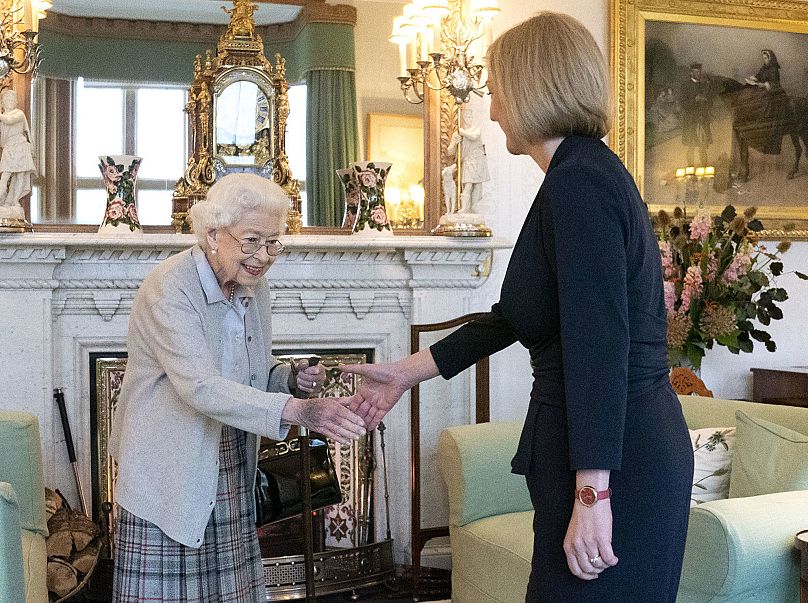From Churchill to Yeltsin and Tito to Trudeau, the Queen's extraordinary reign in pictures
Domestically, she saw 15 UK prime ministers take office. Abroad, she met 13 out of the last 14 US presidents. Here are some of the most important moments during the Queen's record-breaking reign.
Queen Elizabeth II's death on Thursday marks an end to her record-breaking seven decades on the throne, with only France’s Louis XIV ahead of her in the history books.
During her reign, she saw 15 British prime ministers come and go, from Winston Churchill to Liz Truss, via the likes of Margaret Thatcher and Tony Blair.
The monarch also met 13 of the last 14 US presidents, a total of 10 French leaders and seven popes.
Ruling over the Commonwealth, it was Canada that she visited most often — 22 times.
The Queen also set foot in 117 countries and was the first reigning UK monarch to visit Ireland and Russia, among others.
But more importantly, she witnessed the UK and the world change many times over, with more than 100 countries gaining independence in her lifetime.
We look back at some of the most important moments in the life of the beloved British monarch.
Elizabeth famously took the throne in 1952 at the age of 25 upon the death of her father, King George VI.
Cutting her trip to Kenya short, she is seen here as she stepped down from her plane in London, for the first time as sovereign, on 7 February.
Churchill was the first to greet her, together with opposition leader Clement Atlee and other members of the cabinet.
The hero of five wars and a World War II icon, Churchill was infatuated with the young royal, having known her since her birth as a close friend of her father, and the two remained close throughout Churchill's mandate as he believed Elizabeth II embodied all of the hallmark qualities a British sovereign should have to lead the country forward into a new, post-war era.
Despite her being politically non-partisan, it is widely believed that the Queen maintained the most relaxed relations with Labour Party's Harold Wilson, who served as the country's PM in two periods -- between 1964-1970 and 1974-1976.
The leftist leader, who came from a politically active middle-class family, was known for his everyman appeal and quirky, amiable personality.
Wilson also stood out from his more high-class predecessors due to the distinct Yorkshire accent and being only 10 years older than the Queen -- and the friendship the two struck was best illustrated by Elizabeth II inviting Wilson to stay over for drinks and allowing him to smoke his pipe during the weekly meetings she kept with all of her PMs during her reign.
In return, Wilson carried her photo in his wallet and spoke highly of the Queen until his death in 1995.
When "Iron Lady" Margaret Thatcher took office, few believed that she would remain PM for 11 years. The European country was suddenly headed by two powerful women, who did not always see eye to eye.
The differences between the two hinged on their characters: the Queen was famous for her dry wit, while Thatcher did not have a pronounced sense of humour, leading to their meetings being formal and cordial throughout Thatcher's time as prime minister.
Yet Elizabeth II -- who actively served in World War II -- seemed to have had a soft spot for Thatcher, who was just six months her senior and disapproved of the way the Conservative Party disposed of her in 1990.
While the entire world was taken by the charm of US President John F Kennedy and his wife, Jackie Kennedy, the Queen was said to have been not too impressed, mainly due to the criticism both JFK and Jackie had after their 1961 visit to Buckingham Palace.
The presidential couple were not impressed by the palace, and Jackie was believed to have gone as far as to offend her majesty, stating she was "pretty heavy going", according to Gore Vidal.
Yet there is no actual evidence that this ever reached Elizabeth II. Inaugurating a UK memorial for JFK two years after his assassination in 1963, the Queen only had the kindest of words for the late US president.
“The unprecedented intensity of that wave of grief, mixed with something akin to despair, which swept over our people at the news of President Kennedy’s assassination, was a measure of the extent to which we recognised what he had already accomplished and of the high hopes that rode with him in a future that was not to be,” she said at the time.
Having met 13 out of the last 14 US presidents, the Queen was known for having the closest relations with Dwight Eisenhower and Ronald Reagan -- two distinctly different US leaders, both in terms of their political leanings and their background.
Her first state visit to Washington came in 1957, hosted by President Dwight D. Eisenhower, at an important moment for the new sovereign to represent her country with its most important ally.
Eisenhower, the commander of US forces in Europe during World War II, hosted Elizabeth II during her first state visit in 1957, striking up a long-standing friendship that would see Ike, as he was known, visit the Queen in Balmoral, her estate in the Scottish Highlands where she died on Thursday.
Her promise to give him her recipe for scones turned into them becoming pen pals, with the two exchanging letters even after Eisenhower left the office in 1961.
Reagan -- who made a name for himself as a Hollywood actor, mostly appearing in Westerns before becoming president -- also did not hide his sympathies for the Queen, with their friendship revolving around their mutual love of horses.
After visiting Windsor in 1982, Reagan returned the favour by hosting the Queen at his Rancho Del Cielo property in California, serving her a Tex-Mex meal of enchiladas and tacos.
Their close relations also continued after Reagan's presidency ended, while she also awarded him with an honorary knighthood for his country's involvement in the Falkland Wars.
Known for being a Francophile, Elizabeth II had already captured the hearts of the French by the time she was 22, visiting the country instead of her father in 1948.
The first socialist head of state Vincent Auriol awarded her with the Legion of Honour, to which she responded with a speech in impeccable French.
The Queen also famously saved Charles de Gaulle's wife Yvonne of embarrassment caused by her limited knowledge of the English language during the couple's visit to London in 1960, but it was her friendship with François Mitterrand that stood out the most.
The two met on a number of occasions between 1981 and 1995 -- notably at the inauguration of the European Union in 1992 and at the opening of the Channel Tunnel in 1994.
When Elizabeth II last saw Mitterand, she was aware that he was becoming increasingly ill and that it was most likely the final time they would meet. Those present at the meeting said that she practically ran to greet him in a rare show of affection that struck everyone.
After emerging victorious from World War II together with the rest of the Allies, the onset of the Cold War meant that the UK saw its relations with the communist bloc escalate to the point of constant fears of potential nuclear conflict.
However, the Queen did not hesitate to invite the wartime anti-fascist leader of Yugoslavia, Josip Broz Tito, to an official visit to Buckingham Palace as early as 1953.
Just five years prior, the Yugoslav president -- a friend and ally of Churchill -- severed his ties with Joseph Stalin and the Soviet Union and found himself in between two blocs, eventually organising a third, Non-Aligned Movement and keeping the country mostly open to Western influence.
Elizabeth II returned the favour in 1972, with her trip to Belgrade marking the first visit of a UK sovereign to a communist country.
Yet it took another 22 years for her to set foot on Russian soil, another first for a reigning British monarch.
With the Cold War over, following the fall of the Berlin Wall in 1989 and the breakup of the Soviet Union three years later, Elizabeth II embarked on a trip to Moscow hosted by Russian President Boris Yeltsin.
The October 1994 visit was highlighted by what was a very warm welcome by Yeltsin, who had a Rolls-Royce drive the Queen from the airport to the Kremlin and organised a lavish banquet for the British royal, clinking glasses to the renewed UK-Russian relations.
Elizabeth II, in fact, was of Russian descent, having been the great-niece of the Russian Emperor Nicholas II, while her husband Philip also had family ties with the Romanovs. One of the reasons for the Queen's long-standing refusal to visit the USSR was due to the execution of the Russian royal family following the Bolshevik revolution.
Ruling over 14 countries of the Commonwealth, Elizabeth II has long maintained close relations with Canada's leaders, having visited the country on 22 occasions during her seven decades on the throne -- more than any other state in the world -- including father and son Pierre and Justin Trudeau.
Although her relationship with Pierre was often cited as tense, with him being openly critical of "vestiges of colonialism" and acting aloof in Queen's presence, his son had an openly warm relationship with Elizabeth II.
The two first met in 1977 when Justin was just five years old, having arrived with his father at a G7 meeting in London. Finding out about her death, Justin Trudeau said, “as her twelfth Canadian prime minister, I’m having trouble believing that my last sitdown with her was my last”.
"She was one of my favourite people in the world," he told reporters in Vancouver.
On Tuesday -- just two days before her death -- the Queen met Liz Truss, the last prime minister and politician she would receive over her long reign.
Truss, as well as her predecessor Boris Johnson, were both born after the Queen became the British sovereign.
With King Charles III becoming the UK's new monarch on Thursday and Truss being appointed prime minister just two days earlier, this week is very much the start of a new chapter for the country.











